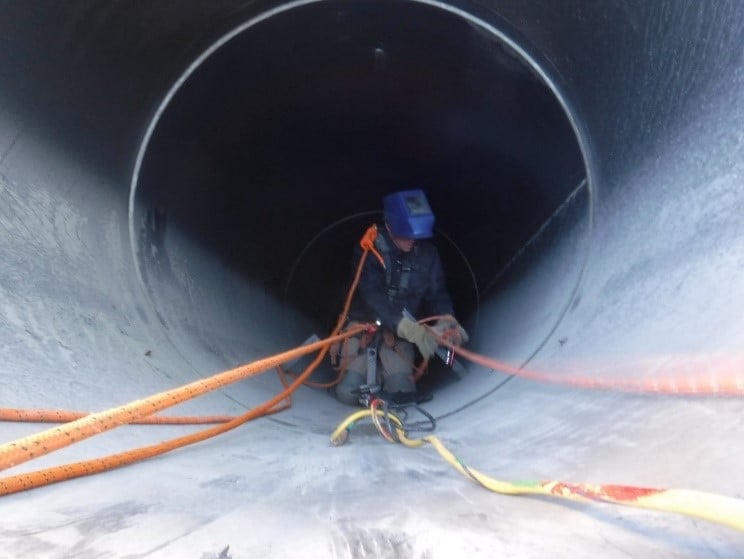A U.S.-based cement plant was experiencing equipment performance problems. False air (leakage) was entering through the ducts and causing the plant to use excessive energy for fan power. Not only that, but there was the potential for additional problems: issues like fluctuating operating temperatures, moisture leaking into the system, and dust emissions that could carry over and cause damage in other parts of the plant or environmental compliance concerns.
Erecting scaffolding to inspect the ducts was not an option during a short outage turnaround, when many other maintenance objectives needed to be accomplished. Not only would it be costly to install, maintain and remove the temporary structure, but the plant’s maintenance team was not specially trained or equipped to handle the project.
In cases like these, materials, energy, and processing plants often outsource the work to service companies with high angle rope inspection capabilities and a good safety plan. High angle inspection brings together the best in technology (e.g., Ultrasonic Testing (UT) devices for measuring wall thickness) with the expertise of highly qualified inspectors, who are able to operate safely in confined spaces. Not only can these professionals examine ducts for corrosion, cracking and other problems, but they can make minor repairs on the spot. These repairs can be a “stop-gap measure” that allows equipment to continue operating before major repairs or replacement are necessary.

With today’s availability of drones and robots, it’s easy to overlook the advantages of the human element when it comes to inspecting the many difficult-to-access locations in industrial environments. In some cases, the ability to inspect an area or piece of equipment remotely may be the optimal choice. But there are circumstances when humans can complete the work quicker and more cost–effectively.
In fact, high angle rope inspection is a very effective method for visual inspections. A trained inspector knows how to properly clean metal down to the bare surface in order to get an accurate reading using a handheld UT device.
One other point would be the line of site/access of inspector to physically see what’s going on. For example, inspecting the internals of an expansion joint requires you to look under another sheet of metal to see what something looks like. You’re really looking at the life of the fabric or metal, which is inside the two flow liners. The ability to get a clear view of the expansion joint helps an inspector determine the condition of the joint fabric or metal. These are things that simply cannot be accomplished satisfactorily with a drone.
High angle rope inspection should not be performed by anyone without the proper training, as well as a safety plan and crew. The NFPA Rope Access Guidelines provide stringent, but important, guidelines for anyone working from a rope. Also, the individual who is on the line doesn’t need to be a ‘rock climber,’ but should be a highly experienced inspector who knows what a flow liner is, who knows how these processes come about, and can understand why the duct is deteriorating. He or she should be able to glean valuable information about the health of the equipment and help address it if necessary. So, it’s about safety and performance. Of course, everything must be compliant with OSHA, which is very strict when it comes to inspector safety requirements.
When it comes to corrosion in difficult to access ducts, stacks, and equipment, just ignoring it and hoping that nothing fails is not a good long-term strategy. It could be 10 or 15 years down the road, but without the proper repairs made inside, maintenance might end up needing to replace the whole duct. Having a human inspector in there, could allow the facility management to extend the life of the duct that much more – without needing a total overhaul. That should be good for almost any type of plant.
High angle rope inspection can provide immediate inspection and minor repair opportunities, but it’s valuable for long-term planning as well. When UT thickness measurements are recorded and supplied to plant operators year after year, it helps build a history that allows them to see the bigger picture. That information enables management to better plan and control the maintenance budget. Regularly scheduled inspections can also help avoid a much bigger hazard: costly equipment failures and unplanned downtime.
As for the outcome at the cement plant, the Engineering Department scheduled its regular service company to provide high angle rope inspection. Holes and cracks were identified in the ducts and expansion joints. Minor repairs were made in these problem areas to reduce the false air flow, decreasing power demand and extending the life of the plant’s aging equipment. Most of the pressing corrosion and erosion issues in the ducts were addressed, and Engineering has scheduled another high angle inspection for its next planned shutdown.
















Comments and Discussion
Add a Comment
Please log in or register to participate in comments and discussions.